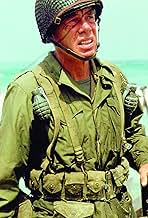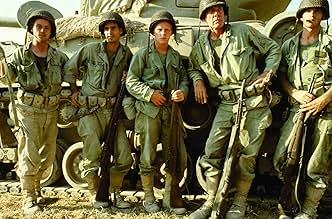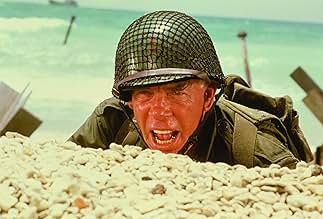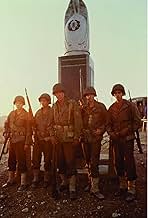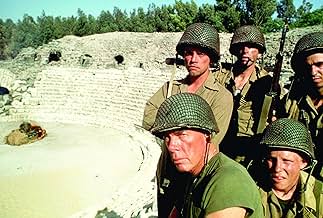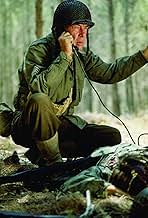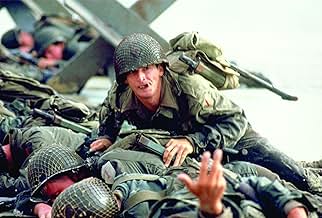CALIFICACIÓN DE IMDb
7.1/10
22 k
TU CALIFICACIÓN
Un curtido sargento y los cuatro miembros principales de su unidad de infantería intentan sobrevivir a la II Guerra Mundial mientras se mueven de batalla en batalla por toda Europa.Un curtido sargento y los cuatro miembros principales de su unidad de infantería intentan sobrevivir a la II Guerra Mundial mientras se mueven de batalla en batalla por toda Europa.Un curtido sargento y los cuatro miembros principales de su unidad de infantería intentan sobrevivir a la II Guerra Mundial mientras se mueven de batalla en batalla por toda Europa.
- Dirección
- Guionista
- Elenco
- Premios
- 2 premios ganados y 2 nominaciones en total
Stéphane Audran
- Underground Walloon Fighter at Asylum
- (as Stephane Audran)
- Dirección
- Guionista
- Todo el elenco y el equipo
- Producción, taquilla y más en IMDbPro
Opiniones destacadas
"The Big Red One" is an episodic war movie from maverick American filmmaker Samuel Fuller. Having only seen "Shock Corridor" from the director's oeuvre, I didn't know what to expect from him this time around. It becomes obvious pretty quickly that Fuller was never going to be a mainstream filmmaker. There's something about his style that's really off-putting. You empathise with the camera, not the actors. It's like they're at odds with each other.
This is not a bad thing, as you can tell from the enthusiastic reception Fuller's movies have gotten here on IMDB. But "The Big Red One" is also drastically cut down from the original print Fuller had, and I wonder if that's why it feels so disjointed.
Of course, it is supposed to be episodic, but I don't know. I didn't really get into it.
This is not a bad thing, as you can tell from the enthusiastic reception Fuller's movies have gotten here on IMDB. But "The Big Red One" is also drastically cut down from the original print Fuller had, and I wonder if that's why it feels so disjointed.
Of course, it is supposed to be episodic, but I don't know. I didn't really get into it.
I have seen this film quite a few times and have always been somewhat puzzled about it. There was no doubt that it had some of the most emotive scenes of any war film but seemed fractured. At times there seemed to be far more realism in it's morality than other films which was understandable since Sam Fuller actually served with The Big Red One at this time so much of it is a first hand account of events and attitudes. I have now read some of the background to the making of the film,I think in the L.A. Times,which now makes sense of the flaws in the film. Apparently Sam Fuller's budget was cut to the minimum by the studios after a regime change and the original screenplay as shot was hacked to death by the same studio against Fuller's wishes. This was not the film he wanted to make but he made it. And it was not the film that he shot as is indicated by the very complete screenplay notes he made. I think it is Richard Schickel, the noted reviewer of Time magazine, who has laboured to find the missing outtakes and to put the film together in its complete form with over 40 minutes added to the length. Apparently this more complete cut significantly improves the film and adheres to Sam Fullers screenplay more accurately. This new cut is now playing to limited audiences and, hopefully, will be available on DVD. It must be emphasized that this is not the film that Fuller originally wanted to make as the budget was cut by 75%. Some of the comments made by other reviewers on these pages are valid as to authenticity specifically in battle scenes. But Fuller did not have the budget that both the Longest Day and Saving Private Ryan had. It will be interesting to see the new cut. Hopefully it will flesh out what could have been one of the greatest Second World War films.
Less than 5 years after the Vietnam War officially ended, Director and acclaimed (but aged) film writer Sam Fuller attempted to recount the experiences he encountered while serving as an infantry soldier in the European Theatre of WW2. He had written many war scripts in his day, but fully realized that the world would not be ready for the true story of WW2, (He is quoted infamously as saying that a truly realistic war picture would involve live grenades and machine guns in the theatre). As his career ended and the world changed, he decided to make a go of his life long pet project... to make a film about the REAL story of WW2, about his own experiences in the Big Red One, or The First Infantry Division.
Too ahead of it's time to be appreciated during it's birth, and too dated to be appreciated in hindsight.
Some of the other user comments suggest this film is inferior to modern war films. Of course this film is not at the caliber of Saving Private Ryan or Band of Brothers in it's war scenes. How could it? When it is of a time closer to The Green Berets (John Wayne wins The Vietnam War) then to anything that came after it. Infact I would go as far as to say that this film broke the first ground, and made films like Platoon, Hamburger Hill, and Full Metal Jacket socially acceptable, and paved the way for films like Saving Private Ryan. Sure, Apocalypse Now has better War scenes, but is so fictional in it's scripting and "epic" war moments that it missed the point of the soldier on the front (and is widely regarded as being unrealistic by Vietnam Vets). The Big Red One tells the story from a WW2 Vet's point of view, Sam Fuller, and is wonderfully acted by a WW2 vet, Lee Marvin. Perhaps the last film to have such credits.
Sure, The Big Red One is cheesy, and harkens to a time when war films were more about the characters, then the violence. Still, there is something charming about the scripting, and Lee Marvin holds the movie together, while being surrounded by actors who were trendy on the cheap for 1979. The film also has technical inaccuracy, as in the Sherman tanks used as Panzers. However, the real strength of the film is in the script, and not in the battles. It breaks ground in it's defiance of films like the Sands of Iwa Jima. The soldier is not a clean sterile fighter for the holiest do goodynest army of all time, he is a human being locked in a battle for survival, and most importantly, he hasn't lost his sense of humor, or his libido.
Regardless of it's dated, almost 70's TV movie feel, I must mention that this film was first to show D-Day in a light other than that cast by The Longest Day, and uses some very clever cinematography to illustrate the violence. Sam Fuller consciously decided to make the battles less violent, and choose to focus on the characters instead, depicted the main characters as cynical and the fallen as humorous tragically short lived figures. This film also was first to introduce words like "replacement", "non-Coms" and "Krouts" to the war movie dictionary. It has the entire bangalore scene from Saving Private Ryan (although merely a concept compared to SPR) and shows North Africa, Italy, France, Germany, and a concentration camp. Before this film, WW2 was only depicted in such an epic manor that Bible films are seemingly tame.
THE BOTTOM LINE: This film was one of the last war pictures to emerge from the dying studio system, and is comparable in the way of battles to The Green Berets, Longest Day, etc. However it shines in the script category. and was first to show soldiers as young clumsy men, and not heroes. It attempts almost too much and that is it's strongest limitation. Still, a must see for war movie fans who can appreciate the older films. 7/10.
Too ahead of it's time to be appreciated during it's birth, and too dated to be appreciated in hindsight.
Some of the other user comments suggest this film is inferior to modern war films. Of course this film is not at the caliber of Saving Private Ryan or Band of Brothers in it's war scenes. How could it? When it is of a time closer to The Green Berets (John Wayne wins The Vietnam War) then to anything that came after it. Infact I would go as far as to say that this film broke the first ground, and made films like Platoon, Hamburger Hill, and Full Metal Jacket socially acceptable, and paved the way for films like Saving Private Ryan. Sure, Apocalypse Now has better War scenes, but is so fictional in it's scripting and "epic" war moments that it missed the point of the soldier on the front (and is widely regarded as being unrealistic by Vietnam Vets). The Big Red One tells the story from a WW2 Vet's point of view, Sam Fuller, and is wonderfully acted by a WW2 vet, Lee Marvin. Perhaps the last film to have such credits.
Sure, The Big Red One is cheesy, and harkens to a time when war films were more about the characters, then the violence. Still, there is something charming about the scripting, and Lee Marvin holds the movie together, while being surrounded by actors who were trendy on the cheap for 1979. The film also has technical inaccuracy, as in the Sherman tanks used as Panzers. However, the real strength of the film is in the script, and not in the battles. It breaks ground in it's defiance of films like the Sands of Iwa Jima. The soldier is not a clean sterile fighter for the holiest do goodynest army of all time, he is a human being locked in a battle for survival, and most importantly, he hasn't lost his sense of humor, or his libido.
Regardless of it's dated, almost 70's TV movie feel, I must mention that this film was first to show D-Day in a light other than that cast by The Longest Day, and uses some very clever cinematography to illustrate the violence. Sam Fuller consciously decided to make the battles less violent, and choose to focus on the characters instead, depicted the main characters as cynical and the fallen as humorous tragically short lived figures. This film also was first to introduce words like "replacement", "non-Coms" and "Krouts" to the war movie dictionary. It has the entire bangalore scene from Saving Private Ryan (although merely a concept compared to SPR) and shows North Africa, Italy, France, Germany, and a concentration camp. Before this film, WW2 was only depicted in such an epic manor that Bible films are seemingly tame.
THE BOTTOM LINE: This film was one of the last war pictures to emerge from the dying studio system, and is comparable in the way of battles to The Green Berets, Longest Day, etc. However it shines in the script category. and was first to show soldiers as young clumsy men, and not heroes. It attempts almost too much and that is it's strongest limitation. Still, a must see for war movie fans who can appreciate the older films. 7/10.
A lot of people hate The Big Red One. They call it farcical, uneven, clichéd. They find it farcical, I believe, because the film revels in the absurdity of war rather than gloss over it. They would rather watch a film, like Saving Private Ryan, which ignores absurdity in favor of violence. These people find it uneven because the "important scenes" (like the D-Day and North African invasion) take only a minute or two to conclude, while other scenes, less typical of a war movie, spread out before us. They call it clichéd because the movie is unsubtle in its treatment of character development and plot.
I cannot agree with these beliefs. The Big Red One is not only one of the greatest WWII films, it is also one of the greatest war movies.
Sam Fuller's film, which was butchered by the studio, is the picaresque tale of 5 members of the First Infantry, known, because of their shoulder patch, as the Big Red One. The film moves from one story to the next without spending too much time on any particular tale.
The individual vignettes, as they must, vary in quality, but on the whole are excellent. The Big Red One stirs within you a desire to run right out and tell your friends about this amazing scene or that.
There's the soldier who loses his testicle, the birthing scene in the belly of a tank, Lee Marvin, in Middle Eastern garb, traipsing across a beach, soldiers dug into holes over which a Panzer tank division travels, the entire Mad House segment... The list goes on.
Some people dislike the absurdest nature of several of this film's stories, but, for me, those surreal touches make this film great.
Without them (and there are a lot), you would be left with a very normal and very boring film. Using bandoleers as stirrups is genius, as is the woman faking crazy as she whirls through a monastery, slicing German throats.
The performances are solid, for this type of film, but if you are looking for subtlety, go elsewhere. Each character is drawn in broad strokes; you never learn too much about them, but you learn enough to understand who they are and why. Lee Marvin, as usual, is amazing. He is one of the great, gruff actors of our time, bringing a special, intangible quality to every film in which I've seen him. He makes every movie he's in better just by showing up. There are too few actors about whom you can say that.
Like the acting, the direction is masculine, but, for a war movie, that's a compliment. In some ways, Fuller's direction here and in his other films reminds me of Hemmingway's writing - terse and effective. Both men believe in an economy of shots or words, depending on their medium, but, through that economy, they attain a muscular sort of poetry akin to the beauty of a horse's rippling muscles as it races on a plain. Fuller's direction here, though not his best when compared to Underworld USA or Shock Corridor, is still better than most, especially considering that this was his first film in several years.
All in all, I find the Big Red One to be an exemplary war movie, even in its emasculated format (I cannot wait to see the restored, 140 minute print, which should improve upon scenes that feel to brief in this version). It's certainly no Apocalypse Now, but it puts to shame most World War II epics before or since.
I cannot agree with these beliefs. The Big Red One is not only one of the greatest WWII films, it is also one of the greatest war movies.
Sam Fuller's film, which was butchered by the studio, is the picaresque tale of 5 members of the First Infantry, known, because of their shoulder patch, as the Big Red One. The film moves from one story to the next without spending too much time on any particular tale.
The individual vignettes, as they must, vary in quality, but on the whole are excellent. The Big Red One stirs within you a desire to run right out and tell your friends about this amazing scene or that.
There's the soldier who loses his testicle, the birthing scene in the belly of a tank, Lee Marvin, in Middle Eastern garb, traipsing across a beach, soldiers dug into holes over which a Panzer tank division travels, the entire Mad House segment... The list goes on.
Some people dislike the absurdest nature of several of this film's stories, but, for me, those surreal touches make this film great.
Without them (and there are a lot), you would be left with a very normal and very boring film. Using bandoleers as stirrups is genius, as is the woman faking crazy as she whirls through a monastery, slicing German throats.
The performances are solid, for this type of film, but if you are looking for subtlety, go elsewhere. Each character is drawn in broad strokes; you never learn too much about them, but you learn enough to understand who they are and why. Lee Marvin, as usual, is amazing. He is one of the great, gruff actors of our time, bringing a special, intangible quality to every film in which I've seen him. He makes every movie he's in better just by showing up. There are too few actors about whom you can say that.
Like the acting, the direction is masculine, but, for a war movie, that's a compliment. In some ways, Fuller's direction here and in his other films reminds me of Hemmingway's writing - terse and effective. Both men believe in an economy of shots or words, depending on their medium, but, through that economy, they attain a muscular sort of poetry akin to the beauty of a horse's rippling muscles as it races on a plain. Fuller's direction here, though not his best when compared to Underworld USA or Shock Corridor, is still better than most, especially considering that this was his first film in several years.
All in all, I find the Big Red One to be an exemplary war movie, even in its emasculated format (I cannot wait to see the restored, 140 minute print, which should improve upon scenes that feel to brief in this version). It's certainly no Apocalypse Now, but it puts to shame most World War II epics before or since.
Some movies are like buried treasure; someone manages to slip them into the theater, practically under every critic's nose, where they either thrive or famish and then vanish into the nearest video catalog. "The Big Red One" is one of those films. For all the hoopla created by "Saving Private Ryan" (another excellent film, which, in my opinion, had a better understanding of it's subject than a lot of it's critics gave it credit for), it owed a great deal to what Sam Fuller did a decade and a half before.
Lee Marvin, an actual WWII veteran himself, holds the film together as the tough but exhausted seargent. When he tells Mark Hamill (yes, Luke Skywalker, folks) that you don't murder animals, you kill them, the look on his face after that seems to say that he wished it could be some other way. It's hard to grab defining moments in this film as stand-out, but the two sequences that stick the most to my mind are the taking of the insane asylum and the horrors of the concentration camp. While other movies have focused on specific campaigns, "The Big Red One" deserves high marks for painting the broad canvass of the Second World War from the perspective of the guys who actually had to do the work.
Lee Marvin, an actual WWII veteran himself, holds the film together as the tough but exhausted seargent. When he tells Mark Hamill (yes, Luke Skywalker, folks) that you don't murder animals, you kill them, the look on his face after that seems to say that he wished it could be some other way. It's hard to grab defining moments in this film as stand-out, but the two sequences that stick the most to my mind are the taking of the insane asylum and the horrors of the concentration camp. While other movies have focused on specific campaigns, "The Big Red One" deserves high marks for painting the broad canvass of the Second World War from the perspective of the guys who actually had to do the work.
¿Sabías que…?
- TriviaThe bulk of the picture was shot in Israel, and director Samuel Fuller remarked that it was unsettling after a scene was shot when the German soldiers and SS troops would take off their helmets and Fuller would see them wearing yarmulkes; also, between takes they would be sitting around the set in full Nazi uniform speaking Hebrew or reading the Torah.
- ErroresDuring the WW1 scene between the Sergeant and the officer in the dug-out, the Sergeant learns that the armistice had been signed 4 hours previously at 1100hrs, November 11, 1918. While talking with the officer, the sergeant is cutting a piece of red cloth in the shape of a number '1' which he says he will submit as a proposed insignia for the division. However the shoulder sleeve insignia for the 1st Division consisting of a red number "1" was already approved on 31 Oct 1918.
- Citas
Johnson: [concerning a woman in labor] How do you say "push" in French?
The Sergeant: Poussez.
Johnson: [to woman] Pussy! Pussy! Pussy!
- Versiones alternativasIn 2004, film critic Richard Schickel restored this film to a new director's cut length of approximately 160 minutes. Using Samuel Fuller's production notes and the full-length, unexpurgated script, Schickel restored the footage that was forced to be cut by the studio upon its original 1980 release (which runs 116 minutes). The restored version's DVD release date is 3 May 2005. This longer, epic-length version is closer to Fuller's original vision for the film.
- ConexionesFeatured in A tout coeur: Episode dated 7 May 1984 (1984)
- Bandas sonorasHorst-Wessel-Lied
Written by Horst Wessel
Selecciones populares
Inicia sesión para calificar y agrega a la lista de videos para obtener recomendaciones personalizadas
Detalles
- Fecha de lanzamiento
- País de origen
- Idiomas
- También se conoce como
- El escuadrón Gran Rojo
- Locaciones de filmación
- Productoras
- Ver más créditos de la compañía en IMDbPro
Taquilla
- Presupuesto
- USD 4,500,000 (estimado)
- Total en EE. UU. y Canadá
- USD 7,206,220
- Total a nivel mundial
- USD 7,206,823
- Tiempo de ejecución
- 1h 53min(113 min)
- Color
- Mezcla de sonido
- Dolby Stereo(original release)
- Relación de aspecto
- 1.85 : 1
Contribuir a esta página
Sugiere una edición o agrega el contenido que falta


